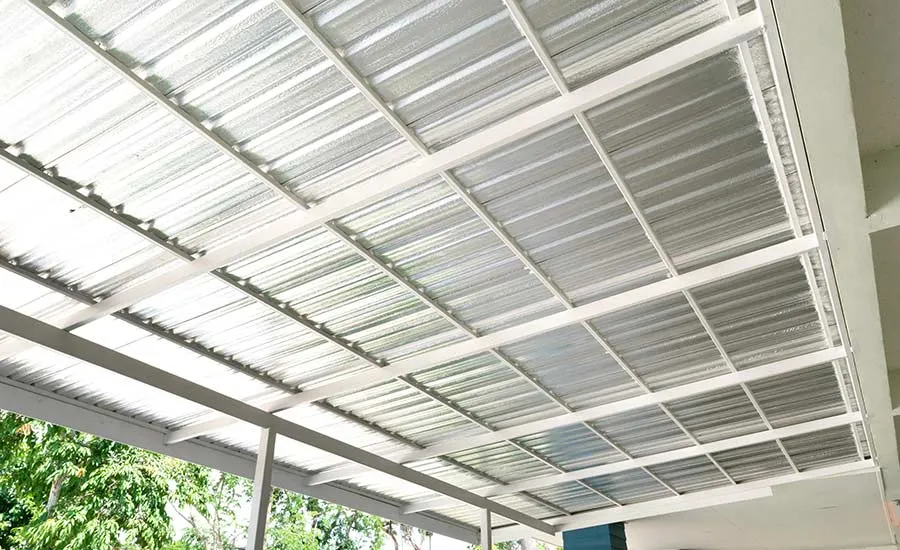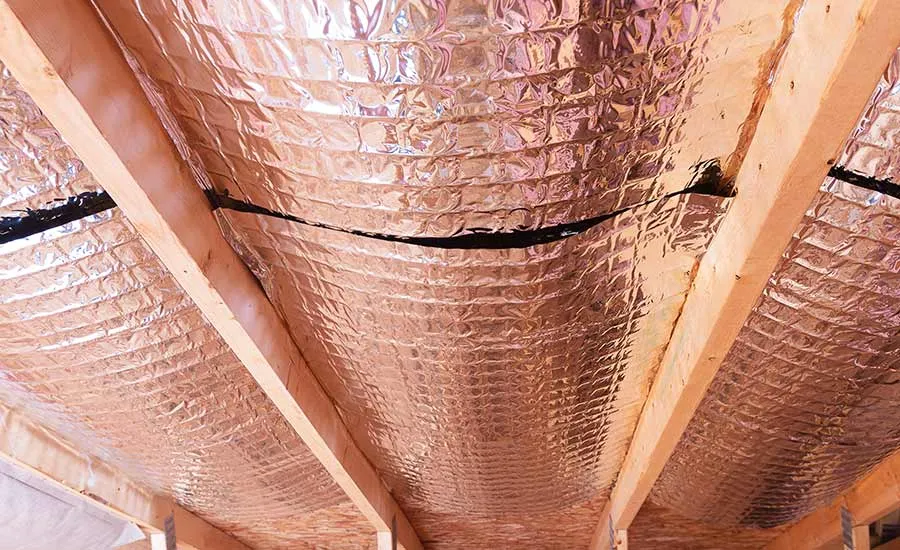How To Install Radiant Barrier Insulation — Your Expert Guide
From building applications and textiles to NASA’s space projects, radiant barriers can reflect radiant heat to secure a temperature-controlled and energy-efficient environment in your home or other structure.
Explore how radiant barrier insulation works, along with different types and a how-to guide for applying it in your home, office, pole barn or warehouse.
Looking for high-quality insulation? Check our best deals!

How Does Radiant Barrier Insulation Work?
On a hot summer day, the heat from the sun penetrates into your home through transparent openings like windows, and also through surfaces like your roof and walls.
Heat moves in three main ways — through conduction, convention and radiation. We’ll explain:
- Conduction: Heat is transferred from the hottest place on a surface to the colder areas. When the sun rays reach your roof, they move inward.
- Convection: When a liquid or gas heats up, its density decreases and it rises. Hot air in your home moves from your rooms to your attic.
- Radiation: Heat radiates out from a heat source. It moves in a straight line and the objects or substances in its path absorb its energy.
On that hot summer day, the radiation from the sun reaches your roof and is absorbed, making it very hot.
If you do not have a radiant barrier, the heat will enter your home through the roof and move into the attic.
With radiant barrier insulation, heat transfer is controlled and blocked from going inside your home. The reflective surface cannot be penetrated, so the heat bounces off.
In this case, the radiant barrier acts like an aluminum surface between your hot roof and your cool bedroom. The hotter it is, the better your radiant insulation works.
Now imagine winter has arrived and it is freezing outside. Your radiant barrier will work in exactly the same way to prevent heat from escaping your home, diverting it to other areas inside instead, so your home stays warm.
What Is Radiant Barrier Insulation Used For?
Radiant barrier insulation is an efficient way to:
- Control the temperature in your home
- Save on energy consumption and bills
You can use radiant barrier insulation in various building and commercial applications, such as:
- Attics
- Basements
- Pole barns
- Crawl spaces
- Garage doors
- Hot water heaters
- Roofs, walls, floors
- Space blankets for survival and first aid applications
- Windows of cars and buildings
Types of Radiant Foil Insulation
Different radiant barriers offer different benefits when it comes to durability, strength, water vapor permeability, flammability and more.
The main types of radiant barriers include:
Aluminum Foil Laminates
This type of radiant barrier is made of plastic films, kraft paper or plywood roof sheathing with a foil laminated on top.
Laminates are thicker but can sag over time due to their weight. They can also undergo delamination, where bubbles accumulate inside when exposed to extreme temperatures.
Aluminized Plastic Films
This radiant barrier includes a thin layer of aluminum particles applied in the form of a film through a vacuum process. You can compare it to the shiny reflective foil inside a bag of chips.
This type is more resistant to extreme heat or moisture compared to the laminate type.
Have insulation-related questions? Contact us!

Radiant Barrier vs. Reflective Insulation
These two terms are often used interchangeably, which is incorrect. While they have similarities, they also have several clear differences.
Both insulation options:
- Contain a metal surface which helps them block heat gain and control heat loss
- Improve energy efficiency
- Use air space during the installation process to increase the insulation value
- Need to be kept dust-free to provide good results
What makes them different from one another?
Radiant barriers are exactly what the name implies — barriers rather than typical insulation. Although they have the ability to reduce heat gain and loss, they have no inherent R-value because they cannot absorb heat and transfer it across air space.
Radiant barriers consist of a single thin surface of metalized film with a reinforced middle part, also known as woven scrim.
When installed to face an enclosed air space, the radiant barrier turns into a radiant barrier system or reflective insulation with a measurable R-value.
Reflective insulation has a middle part made of foam, bubbles or fiberglass enveloped by two or more surfaces of foil. The foil surfaces cannot touch due to the structure of the bubbles and foam. This allows air to get trapped inside, which increases the R-value.
Another difference between the two is that reflective insulation prevents moisture and condensation — especially when used in metal and steel buildings.
Not sure which type of insulation to use? Contact us!
How To Install Radiant Barrier Insulation
Radiant barrier insulation can be used throughout your home, including in your attic, rooms or crawl spaces. Let’s take a look at the most common methods of installation.
Attics
For attic use:
- Rafter/truss installation: Drape your radiant barrier over the trusses, making sure the foil faces downwards.
- Under, or pre-laminated to, roof sheathing: Place the radiant barrier under the roof sheathing, with the foil side facing down.
- Horizontal installation: Apply directly above the ceiling and/or existing ceiling insulation.
If you want to combine radiant barriers with other insulation options in your attic, keep in mind:
- Check your ceiling materials and insulation for signs of moisture. If you find any indications, eliminate the cause of the moisture before applying your radiant barrier.
- Apply the radiant barrier on top of the other insulation without taping or stapling it. Make sure that there is very loose contact with the material under it.
- Make sure that dust does not accumulate on top of your radiant barrier.
- Follow the ASTM standards for flame spread, smoke development and water vapor transmission.
- Verify your radiant barrier characteristics with your local building codes.
Walls
To use radiant barriers in the walls of your home or metal building:
- Apply a radiant barrier to your vented skin wall.
- Separate the internal structural wall and the outer skin with the help of furring strips.
- Wrap the wall with a radiant barrier facing the vented air space.
Floors
You can use a radiant barrier above your unheated basement or crawl space to take advantage of its thermal properties and its ability to block moisture from entering your home.
We recommend two methods of installation:
Option 1:
- Staple the radiant barrier to the underside of the floor joists.
- Leave a single reflective air space.
Option 2:
- Apply the radiant barrier between the joists.
- Add sheathing.
- Leave two separate reflective air spaces.

Tips For Installing Radiant Insulation
A professional installation company can ensure the best results with radiant barrier insulation by installing it correctly.
However, if you are confident you can do it on your own, here are some tips to ensure the best results.
- Read and follow the manufacturer’s instructions.
- Apply your radiant barrier in places where it will stay warm enough without reaching the dew point temperature. This means any place in your home where the surface temperature is over 17-18ºC and there is relatively low humidity and good ventilation.
- If you install radiant insulation in a new home, drape the rolled foil with its foil face down between the roof rafters. This will minimize the accumulation of dust on the reflective surfaces. The best time to do it is before the roof sheathing is placed.
- If the roof is already on the home or building staple the radiant barrier to the bottom of the rafters from inside the attic.
- Allow your radiant barrier to "droop" between the attachment points to ensure a minimum of 2.5 cm of air space between it and the bottom of the roof.
- Do not apply the radiant barrier insulation directly on top of attic floor insulation because it may trap moisture.
- Make sure you have proper ventilation to prevent dust from accumulating. Radiant barriers work properly only in well-ventilated spaces where they remain dust-free.
- Use perforated radiant barriers to prevent the accumulation of moisture.
- Inspect your insulation at regular intervals to identify and patch up leaks, condensation issues and other moisture problems.
What To Remember About Radiant Barrier Insulation
Used alone or in combination with traditional insulation options, radiant barriers can help control the temperature inside your home or other structure and reduce energy bills.
Radiant barriers can be used in attics, walls and floors following specific instructions to increase their efficiency.
At Insulation4Less, we have 18 years of industry expertise and our professionals can answer all of your insulation-related questions and assist with professional installation, no matter what your project involves.
We offer:
- The best rate for the highest quality insulation
- Same day shipping
- Expert guidance and recommendations
Need help with radiant barrier installation? Contact us!






